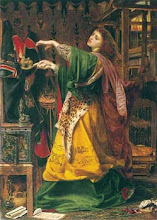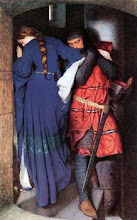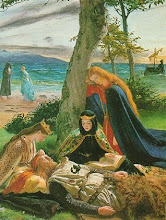
by Edileide Brito
Arthurian Legend emerges from Celtic folklore, probably Arthur was a Celtic King or a warlord ruling a Celtic territory. Supposing who Arthur has existed in fact, around 5th or 6th century,certainly was a period where the society was quite influenced to rule in a Catholic mind. Knowing that all the Arthurian Lore consisted in oral tradition, monks passed to register this orally tradition through the writings, arising the tales. Eventually Roman Catholic writers, the only writers permitted, finally started writing the history of pre-Christian Europe. However, as Catholics under the full official censorship and 'nihil obstat' (nothing offensive to the Church), the bowdlerized versions contained obvious omissions and revisionist histories (nothing lasted about Pagan Solstice celebrations even though there are hundreds of Solstice monuments in Europe, for instance) and only strained glimpses into the real pre-Christian history. About 1160 AD, the Catholic French writer, Chretian de Troyes, wrote a series of romantic Christian morality plays and grabbed the name of Pagan King Arthur and other 500 AD Pagan characters, put them into medieval clothes and castles and gave them Christian attitudes. This is the first of the modern romantic/Christian Arthurian tales. Following the same de Troyes/Christian romance formula, many other Catholic writers wrote romantic tales with Arthurian or Arthurian like elements in titular or background format. The most notable in English is Sir Thomas Mallory's Le Morte d'Arthur (1485) which based his work in two sources: A Welsh source and other French, inspired in Vulgate Cycle whose creator was Chretièn de Troyes.The Arthurian tales have continuing background in Celtic and Pagan elements. The constant white horse is the Celtic horse/Goddess Epona, revered also by Pagan Romans, and used as a modern symbol by many corporations. The sword Excalibur, stuck in a boulder, will only be released when the Earth Goddess/Mother gives permission, represents a Pagan tradition. Excaliber must be returned to the "lady", and is finally thrown into a lake, was caught by the "Lady of the Lake" and disappeared below. The practice to throw weapons in the lake was common among the Celts, and regarded a rite in Pagan Society. Llyn Cerrig Bach is a lake in the northwest of the island of Anglesey, Wales. Its main claim to fame is the large hoard of Iron Age materials discovered there in 1942, apparently placed in the lake as votive offerings. These finds are considered to be one of the most important collections of La Tène metalwork discovered in the British Isles.The intensity of these mythologies are very broad and make us to think about the concept of religion and in the myths and gods that these people believed, providing from their politheism, a pagan society kept a direct relation with their myths and gods and they were always presented during their festivals, ritualistic ceremonies, in the hunt, in the agriculture, in the nature and in particular life. The gods and their myths became timeless and they are alive and presentified in the beliefs and all the folklore that compound the British Tradition.






































